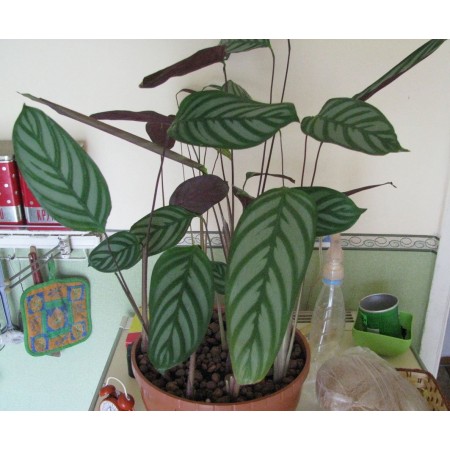Growing Chtenantas

Ktenanta is a beautiful exotic plant, which differs from other varieties from the family of Maranta oval leaf shape and unpretentiousness in care. It is very simple to grow it at home, and in this article we will try to answer all the questions of gardeners planning to place young flowers in the room.
Home lighting
Initially, the ktenant appeared in places reliably protected from the sun by the dense crowns of tall trees. Accordingly, this flower is not very demanding on lighting, and it does not necessarily need to be given stable access to sunlight. True, well-lit places will affect the ctenant very positively, and the flower will feel very comfortable on the windowsills on the north side of the house.
There is no way to provide flower access to natural light? Do not be discouraged, the ctenant can bloom under artificial lighting, which should be maintained in the house for 16 hours a day. If you have the opportunity to place the flower on the eastern and western window sills, then during sunrise and sunset between the flowerpot and the sun, protection should be provided, since the leaves of the flower may fade and become small from abundant lighting.
Temperature, humidity and watering
The only main requirement for the constant growth of the ctenantas is to maintain a stable temperature in the room. It should not fall below 20 degrees of heat throughout the year, and the soil should be warmed up to a minimum of 18 degrees. If the root system of the flower is too cold, it will quickly fade and die.
At the very beginning of the period of life, home ctenants should provide her with conditions that will be as similar as possible to her family. This rule applies to humidity - it must be high, and to maintain an acceptable level it is recommended to constantly spray the flowerpot from the spray gun. It will not be superfluous to place a bath with water next to the pot - this way the plant will get enough moisture and will be able to please us with active flowering.
Before watering, it is necessary to determine whether the earthen lump in the pot with the ctenant has dried. This is important, since it is strictly not recommended to fill the soil - from the abundance of moisture a flower can quickly lose its splendor. The moisture for irrigation should also be selected specific, since the liquid flowing from the tap contains too much iron and salts. Also, the water needs to be warmed to room temperature, having previously stood for a day.
Feeding and transplanting
If before placing the ctenants correctly select the soil and periodically transplant it, then you can completely forget about top dressing. If the flower stopped growth (in all months except winter), then it is possible to apply mineral fertilizers for several months.
Once a year, a young plant should be transplanted, while a more mature flower moves to other flowerpots twice less. The container should correspond in size to the splendor of the root system of the ctenantas - the flower should feel as comfortable in the "new house" as possible.